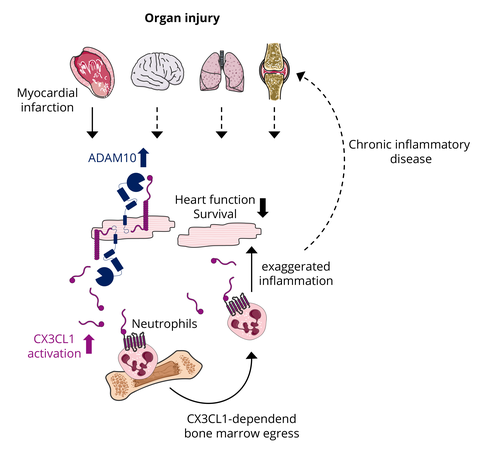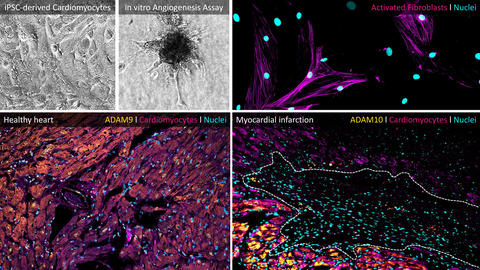Molecular Immunopharmacology of the heart
Despite lege artis treatment with inhibitors of the neurohumoral axis (β-adrenoreceptor blockers), the renin-angiotensin-aldosterone system (angiotensin-converting enzyme inhibitors, angiotensin-II receptor antagonist, mineralocorticoid receptor blockers) and, more recently, the natriuretic peptide system (angiotensin-II receptor / neprilysin inhibitors) as well as glucose metabolism (SGLT2 inhibitors), chronic heart failure, e.g., as a result of a heart attack, remains a major clinical challenge.
Following myocardial infarction, the inflammatory response is a key determinant in the development of chronic heart failure. On the one hand, infiltration of immune cells, such as neutrophils and macrophages, is essential for clearance of cellular debris and subsequent scar formation. On the other hand, exaggerated infiltration of immune cells also contributes to further myocardial damage. Thus, reducing immune cell infiltration to a level that ensures adequate healing of the infarcted area but prevents further damage of the myocardium is a promising therapeutic option for patients with myocardial infarction.
Immune cell migration is critically regulated by the secretion of chemokines, which bind to corresponding chemokine receptors on the surface of immune cells and thus influence their migratory behavior. The activity of chemokines is in turn controlled to a considerable extent by metalloproteases of the ADAM family (A-disintegrin and metalloprotease). Thereby, ADAMs coordinate leukocyte recruitment, attachment and transendothelial migration through proteolytic cleavage of cell surface-bound cytokines (TNFα), chemokines (CXCL16 and CX3CL1) and their corresponding receptors (TNFRI / II, IL-1R2, IL-6R).
Our research group aims to contribute to a better understanding of the molecular mechanisms controlling the immune response after infarction to find new therapeutic approaches for infarct patients. In particular, we focus on studying proteolytic enzymes such as ADAM10, ADAM-interacting chemokines, and their effects on immune modulatory processes (especially of neutrophils), cardiac function and fibrotic remodeling of the heart after myocardial infarction.
ADAM10 drives CX3CL1-mediated neutrophil bone marrow egress and tissue infiltration upon organ injury. Schematic depiction of the effects of activated ADAM10 on neutrophil migration. Upon myocardial injury, active ADAM10 leads to induction of cardiomyocyte CX3CL1 (Fractalkine) ectodomain shedding which drives neutrophil bone marrow egress and heart tissue infiltration. Exaggerated ADAM10/CX3CL1 leads to reduced survival and organ function upon myocardial injury and is anticipated to interfere with the dynamic events worsening chronic inflammatory disease
Methods
- cardiomyocyte specific Adam10 knockout mice, immune cell reporter mice
- induced pluripotent stem cell technology (iPSCs)
- CrisprCas9-ediated gen knockout
- Molecular protein biochemistry
- Histology
- Fluorescence micoscopy
- Fluorescence activated cell sorting (FACS)
- OMICS: RNA sequencing Mass spectrometry (in cooperation)


